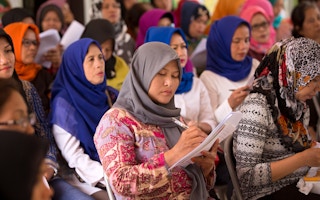Southeast Asia’s e-commerce market could grow by more than US$280 billion by 2030 by increasing the number of women selling on online platforms and providing them with better training and financial support, a new report by International Finance Corporation (IFC) has found.
To continue reading, subscribe to Eco‑Business.
There's something for everyone. We offer a range of subscription plans.
- Access our stories and receive our Insights Weekly newsletter with the free EB Member plan.
- Unlock unlimited access to our content and archive with EB Circle.
- Publish your content with EB Premium.
In recent years, e-commerce has reduced many of the barriers to entry traditionally faced by women and given them the opportunity to compete in new sectors.
Women now comprise half of all active e-commerce vendors in Southeast Asia, but they are less prepared to withstand shocks as women-owned businesses tend to be smaller, have fewer resources, and are concentrated in lower margin sectors such as agriculture, catering, and beauty.
While Covid-19 caused a surge in online sales globally, it disproportionately impacted women micro, small, and medium-sized enterprises (MSMEs) and caused a drop in women’s sales.
Prior to the pandemic, women were on track to reach gender parity in e-commerce, and were even outselling men in terms of gross merchandise value (GMV). In 2019, women had an average GMV of 106 per cent and 164 per cent of men-owned businesses in the Philippines and Indonesia, respectively.
But when the pandemic hit, women’s GMV dropped by 27 per cent in the Philippines and 44 per cent in Indonesia—reversing the initial successes of women-owned businesses and increasing the gender gaps in e-commerce.
According to the report, if women’s gross merchandise value were to reach parity with men in 2025, US$280 billion of additional market value would accrue between 2025 and 2030. In other words, for every year that the gender gap remains unaddressed, the sector loses over US$46 billion of potential value.
The report draws on data from one of Southeast Asia’s largest e-commerce platforms, Lazada, and is the first large-scale, sex-disaggregated analysis of e-commerce sellers in the region.
But why were women’s sales negatively impacted by the pandemic?
Women-owned businesses entered the sector with substantial disadvantages, including gaps in connectivity and access to finance, which limits their ability to work in tech-enabled jobs or to compete as entrepreneurs.
On average, women-owned businesses in the region also operate with smaller and less diverse networks than men, and have less access to information. IFC found that female entrepreneurs that have been in financial distress due to the pandemic, have not been able to service their bank loans. They have not received proper support from their banks on loan restructuring and as a result, have had to borrow from their family and friends to pay employee salaries.
This is compounded by factors such as the closure of schools and childcare services, which have resulted in additional caregiving responsibilities and less time for women to devote to their business.
In addition, the pandemic has increased women’s vulnerability to domestic violence and gender-based violence online. As women-owned businesses tend to employ more women, closures and the resulting job losses could also have a ripple effect and exacerbate gender inequality.
The report also found that e-commerce platforms, investors and policymakers are well-positioned to reverse the current trend and support female entrepreneurs in an industry that will increasingly define business in the region and globally.
Selected actions include ensuring that women entrepreneurs are aware of and can access emerging fintech offerings, such as in-platform loans, which women currently access at much lower rates than men.
They could also target women-owned businesses for training, encourage women’s participation in high value segments such as electronics, and incentivise women sellers to use paid platform features on online platforms, such as product advertisements to boost sales.
Since 2015, the e-commerce market has tripled in size, growing to a value of US$105 billion. Similar trends could lead to another tripling—to US $309 billion by 2025. In this research, IFC has found that this growth could be even higher if e-commerce platforms and companies across the tech sector invest in women and grow an inclusive digital economy.










